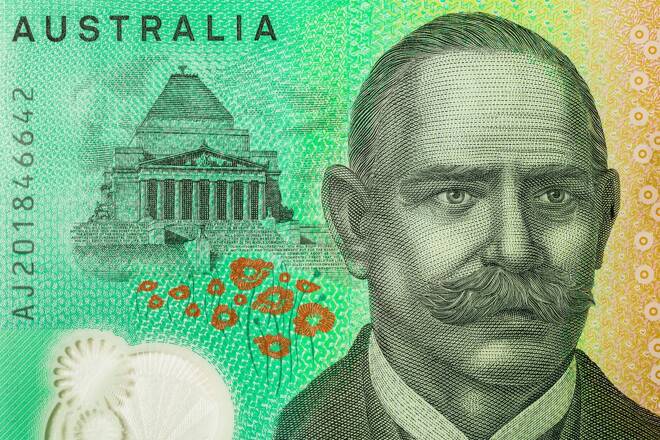Advertisement
Advertisement
AUD to USD Forecast: China Stimulus and US Manufacturing in Focus
By:
It is an important week for the Aussie dollar, with retail sales and inflation figures to influence the RBA interest rate decision on February 6.
Highlights
- The AUD/USD declined by 0.17% on Friday, ending the session at $0.65737.
- US personal income and spending offset the effects of softer inflation numbers, leaving the AUD/USD in negative territory.
- On Monday, investors will begin considering Aussie retail sales, inflation numbers, and the Fed interest rate decision.
Friday Overview of the AUD/USD
The AUD/USD declined by 0.17% on Friday. Reversing a 0.11% gain from Thursday, the Australian dollar ended the session at $0.65737. The Australian dollar rose to a high of $0.65805 before falling to a low of $0.65704.
Aussie Inflation and China Stimulus Plans in Focus
This week, Q4 inflation numbers from Australia could influence the RBA interest rate decision on February 6. The inflation numbers are out on Wednesday. Economists forecast the annual inflation rate to soften from 5.4% to 4.3% in Q4.
Hotter-than-expected inflation numbers could raise bets on an RBA rate cut next week. In December, the RBA considered raising interest rates before deciding to review another round of data. The Australian Monthly CPI Indicator justified the RBA leaving the cash rate at 4.35%. According to the Monthly CPI Indicator, the annual inflation rate softened from 4.9% to 4.3% in December.
Nonetheless, uncertainty about household spending remains a bugbear. An upward trend in household spending could drive demand-driven inflation and yield and RBA rate hike. Australian retail sales jumped by 2.0% in November. However, economists forecast a 1.9% slide in retail sales in December. The numbers are out on Tuesday.
A sharp fall in retail sales and softer-than-expected inflation could close the door on further RBA rate hikes.
There are no Australian economic indicators for investors to consider on Monday. However, investors must monitor stimulus chatter from Beijing. A meaningful stimulus package would drive buyer demand for the Aussie dollar.
US Economic Calendar: Dallas Fed Manufacturing Index
On Monday, the Dallas Fed Manufacturing Index will be in focus. Economists forecast the Index to slide from -9.3 to -23.0 in January. Weaker-than-expected numbers could test expectations of a US soft landing.
The manufacturing sector contributes less than 30% to the US economy. However, investors remain sensitive to recessionary signals.
Last week, softer US inflation numbers countered better-than-expected private sector PMIs, US GDP numbers, and personal spending numbers, leaving bets on a March Fed rate cut unchanged.
According to the CME FedWatch Tool, the probability of a 25-basis point March rate cut stood at 46.2% on Friday, unchanged from the previous Friday.
Short-Term Forecast
Near-term AUD/USD trends hinge on Australian retail sales and inflation figures. An unexpected spike in retail sales and hotter-than-expected inflation could fuel bets on an RBA rate hike. Monetary policy divergence could tilt toward the Aussie dollar before the Fed interest rate decision (Wed).
AUD/USD Price Action
Daily Chart
The AUD/USD sat below the 50-day and 200-day EMAs, sending bearish price signals.
An AUD/USD breakout from the 200-day EMA would support a move through the $0.66162 resistance level and the 50-day EMA. A break above the 50-day EMA would bring the $0.66500 handle into play.
China stimulus chatter, market risk sentiment, and the US economic calendar need consideration.
However, a drop below the $0.65500 handle would give the bears a run at the $0.64900 support level.
A 14-period Daily RSI reading of 38.72 suggests an AUD/USD fall through the $0.65 handle before entering oversold territory.
4-Hourly Chart
The AUD/USD remained below the 50-day and 200-day EMAs, affirming the bearish price signals.
An AUD/USD break above the 50-day EMA would support a move to the $0.66162 resistance level.
However, a break below the $0.65500 handle would give the bears a run at the $0.64900 support level.
The 14-period 4-Hourly RSI at 44.82 indicates an AUD/USD fall to the $0.64900 support level before entering oversold territory.
About the Author
Bob Masonauthor
With over 28 years of experience in the financial industry, Bob has worked with various global rating agencies and multinational banks. Currently he is covering currencies, commodities, alternative asset classes and global equities, focusing mostly on European and Asian markets.
Latest news and analysis
Advertisement
